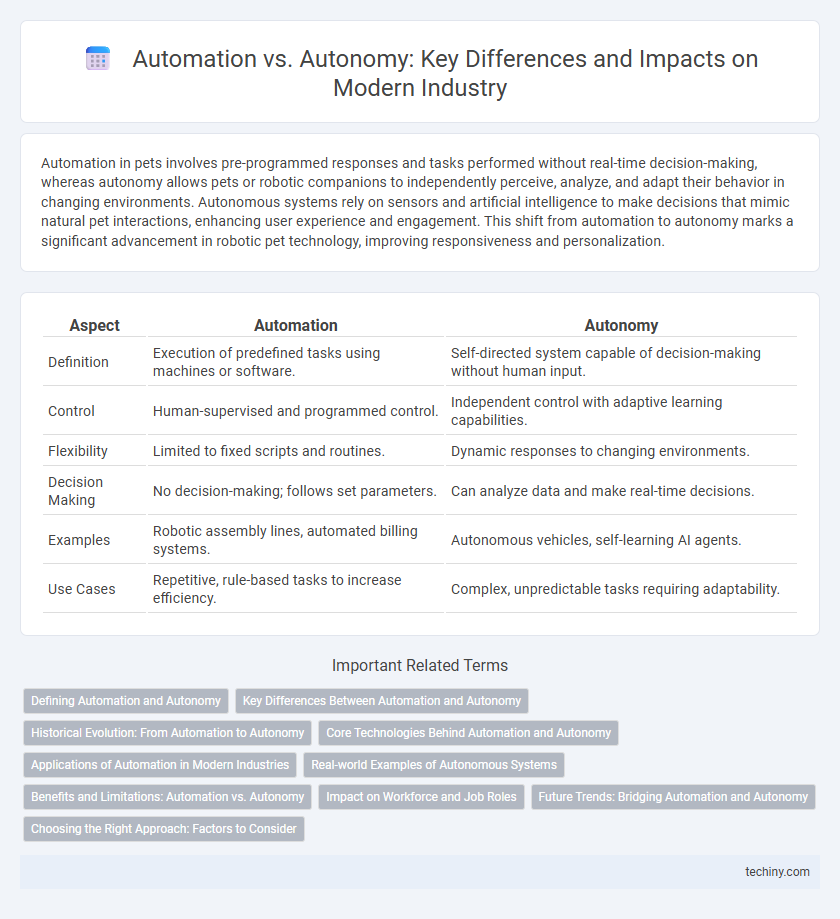Automation in pets involves pre-programmed responses and tasks performed without real-time decision-making, whereas autonomy allows pets or robotic companions to independently perceive, analyze, and adapt their behavior in changing environments. Autonomous systems rely on sensors and artificial intelligence to make decisions that mimic natural pet interactions, enhancing user experience and engagement. This shift from automation to autonomy marks a significant advancement in robotic pet technology, improving responsiveness and personalization.
Table of Comparison
| Aspect | Automation | Autonomy |
|---|---|---|
| Definition | Execution of predefined tasks using machines or software. | Self-directed system capable of decision-making without human input. |
| Control | Human-supervised and programmed control. | Independent control with adaptive learning capabilities. |
| Flexibility | Limited to fixed scripts and routines. | Dynamic responses to changing environments. |
| Decision Making | No decision-making; follows set parameters. | Can analyze data and make real-time decisions. |
| Examples | Robotic assembly lines, automated billing systems. | Autonomous vehicles, self-learning AI agents. |
| Use Cases | Repetitive, rule-based tasks to increase efficiency. | Complex, unpredictable tasks requiring adaptability. |
Defining Automation and Autonomy
Automation involves using technology and systems to perform tasks with minimal human intervention, enhancing efficiency and consistency in processes. Autonomy refers to machines or systems possessing the capacity for self-governance, decision-making, and adapting to changing environments without external control. While automation executes predefined actions, autonomy enables independent judgment and dynamic responses based on real-time data.
Key Differences Between Automation and Autonomy
Automation involves pre-programmed tasks executed without human intervention, relying on fixed rules and predictable environments. Autonomy enables systems to make independent decisions using real-time data and adaptive learning algorithms. Key differences include the level of intelligence, decision-making capability, and responsiveness to dynamic conditions.
Historical Evolution: From Automation to Autonomy
The historical evolution from automation to autonomy marks a critical shift in technology where simple mechanized tasks have progressed to intelligent systems capable of self-governance. Early industrial automation relied heavily on programmed instructions and fixed algorithms to perform repetitive tasks, while modern autonomous systems incorporate artificial intelligence, machine learning, and real-time data processing to adapt and make decisions independently. This transition reflects advancements in robotics, sensor technology, and computing power, enabling machines to operate with minimal human intervention across complex and dynamic environments.
Core Technologies Behind Automation and Autonomy
Core technologies behind automation include robotic process automation (RPA), machine learning algorithms, and sensor networks that enable repeatability and precise control in industrial tasks. Autonomy leverages advanced artificial intelligence, deep learning models, and real-time data processing to enable independent decision-making and adaptive behavior in complex environments. Integration of computer vision, natural language processing (NLP), and edge computing further distinguishes autonomous systems by enhancing situational awareness and responsiveness beyond automated workflows.
Applications of Automation in Modern Industries
Automation drives efficiency in modern industries by enabling repetitive tasks to be executed with precision and speed, reducing human error and operational costs. Key applications include robotic process automation in manufacturing, automated supply chain management, and intelligent systems in quality control. These technologies facilitate scalability and innovation while allowing human workers to focus on strategic and creative roles.
Real-world Examples of Autonomous Systems
Autonomous systems, such as self-driving cars developed by companies like Waymo and Tesla, demonstrate advanced decision-making capabilities that surpass traditional automation by adapting to complex real-world environments without human intervention. Drones used in agriculture, equipped with AI-powered sensors, autonomously monitor crop health and optimize spraying protocols, reducing labor costs and increasing efficiency. In industrial settings, autonomous robots from firms like Boston Dynamics perform intricate tasks such as material handling and quality inspections, showcasing the shift from automated repetition to intelligent, context-aware operations.
Benefits and Limitations: Automation vs. Autonomy
Automation enhances efficiency by executing predefined tasks with precision and consistency, reducing human error in repetitive processes. Autonomy advances decision-making capabilities through adaptive learning and real-time problem solving, enabling systems to operate in complex, dynamic environments. Limitations of automation include rigidity and lack of adaptability, whereas autonomy faces challenges in reliability, ethical decision-making, and the need for advanced AI integration.
Impact on Workforce and Job Roles
Automation replaces repetitive tasks with machines, streamlining workflows and increasing efficiency, while reducing the demand for manual labor in industries like manufacturing and logistics. Autonomy emphasizes intelligent systems capable of decision-making, shifting worker roles toward oversight, maintenance, and strategic management of autonomous technologies. This transition drives workforce reskilling, creating opportunities in technology development and system optimization while phasing out routine operational jobs.
Future Trends: Bridging Automation and Autonomy
Future trends in automation emphasize the integration of autonomy to create intelligent systems capable of self-learning and decision-making without human intervention. Advances in AI, machine learning, and sensor technologies drive the evolution from rigid automated processes to adaptive autonomous solutions in industries such as manufacturing, transportation, and healthcare. This convergence enables real-time optimization, increased efficiency, and enhanced operational resilience, defining the next generation of smart automation.
Choosing the Right Approach: Factors to Consider
Choosing between automation and autonomy depends on the complexity of tasks, desired flexibility, and the level of human oversight required. Automation excels in repetitive, rule-based processes, offering efficiency and consistency, while autonomy is suited for adaptive, dynamic environments needing decision-making capabilities. Key factors include the nature of the operation, risk tolerance, integration with existing systems, and scalability requirements.
Automation vs Autonomy Infographic

 techiny.com
techiny.com